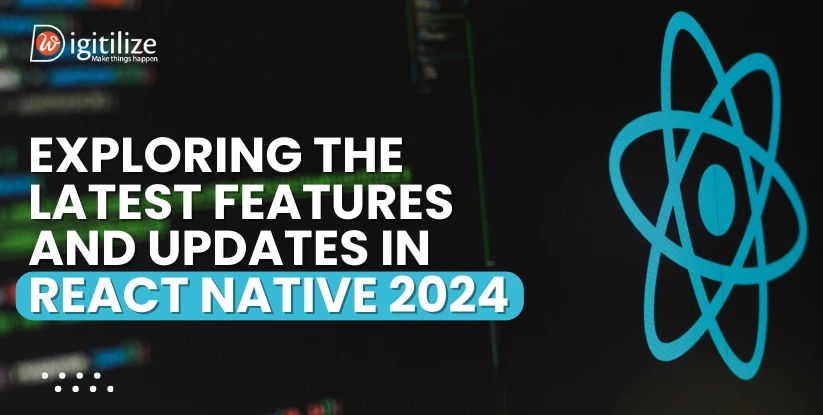Exploring the Latest Features and Updates in React Native 2024

React Native has a bright future ahead of it, one that promises efficiency, creativity, and improved user experiences in 2024. So, this blog is exploring the latest features and updates in React native 2024. We can assure you that react native will have a significant influence on the app development industry going forward. In 2015, Facebook developed react native, first for iOS and then for Android. This made it possible to build a mobile application simultaneously on two platforms while maintaining the app’s original look, feel, and functionality.
Fifth place goes to React Native, with 14.51 percent of the vote. Despite its shortcomings, React Native is apparently a very useful tool for platform-independent mobile programming. Combining React Native with cutting-edge technologies like artificial intelligence (AI) and machine learning (ML) allows apps more dynamic and intelligent functionality, based on the highly desired change. In an attempt to obtain a competitive advantage, React Native has recently been included into the frameworks of Facebook, Instagram, Airbnb, and Salesforce.
Understand the react native in 2024
One of the key players in the area of developing mobile apps is React Native. This special framework uses JavaScript to construct native iOS and Android apps by using React’s declarative UI structure. Furthermore, all the while upholding the accepted guidelines for native apps. Without needing to master specialised programming languages, developers may create adaptable mobile apps using this technology that function flawlessly across a variety of platforms.React Native provides much more than simply a quick fix for creating cross-platform apps, though, once you get beyond its convenience aspect. To maintain compatibility with modern devices, the framework integrates important functionality and security improvements from both the iOS and Android platforms with each new version release.
React Native was updated to properly support Android 14. React Native developers may now target API Level 34, the most recent version of the Android SDK, starting at 0.73.
Benefits of React Native 2024

-
Saves Money and Time
-
Faster Publication of Updates
-
Incredible Performance
-
Lower expenses for app development
-
Outstanding atmosphere for support
-
Assistance with third-party plugins
Top React native trends in 2024

-
Serverless Architecture
-
Static site generators
-
Component-Based Design Systems
-
Functional Programming
-
Machine Learning
-
Tested and Tried
Every mobile application developed by Facebook is made using React Native. React Native has also been used by Tesla, Wal-Mart, and AirBnB, among other well-known companies. For the developers, all of these increase the trust factor.
-
TypeScript Develops
In conclusion, as new trends and technologies emerge, React native development is always changing. If developers want to produce better and more inventive apps, they need keep up with the most recent developments and trends.
-
A Transformation for JSX
-
Concurrent Mode to Boost Speed
-
Increased Interoperability
Top updates of React Native 2024

-
ESLint Plugin
-
Concurrent Mode
-
Enhanced Developer Tools
-
GraphQL Integration
-
Evolution of State Management
React Native’s Next Step is Fabric
The massive project known as Fabric is being worked on by React Native. React Native’s rendering layer is recreated using this most recent rendering technology. The project’s goal is to improve react native’s responsiveness, and its architecture will make it easier for react native to integrate with infrastructure that is built on hybrid JavaScript.The important adjustments that Fabric can make for react native programming are being described by the developers. Three key developments that the Fabric developers see to drive react native growth going forward.
-
A New Threading Framework
-
Asynchronous Rendering Features
-
Simplified Bridge
Comparison of Other Cross-Platform Frameworks with React Native 2024
React Native is a popular cross-platform framework, but it’s critical to know how it stacks up against alternatives like Flutter and Xamarin. Because of its extensive ecosystem of libraries and tools, maturity, and strong community support, React Native maintains a substantial advantage in 2024. When companies choose a technological stack for the development of their mobile apps, this comparison becomes crucial. Our post on react native good for developing an app in 2024 offers a thorough comparison for a more in-depth examination, assisting companies in making an informed choice.React Native’s ability to interface with already-existing native apps is one of its special features. This implies that companies don’t have to completely redesign their programmes in order to progressively implement React Native for specific areas of them. This gradual adoption approach has the potential to be less disruptive and extremely cost-effective. It is essential for businesses thinking about using this strategy to comprehend the intricacies of integration. Our React Native development services can help companies with this process and make the transition seamless.
The Best Ways to Deploy React Native Apps
Following advised practices is crucial while delivering a React Native application. Since Android and iOS have different design standards and user interface elements, this entails optimising the native software for different platforms. The consumers of each platform will benefit more from native apps as a result.-
Testing on a Variety of Devices
-
The App Store Approval Process
One of the challenges faced by developers when making mobile apps, especially those made using React Native technology, is this intricacy.
-
Performance Optimisation
-
Security Measure
There will be around 7.07 billion smartphone users worldwide in 2024. This will present a number of chances for the market for mobile apps to expand rapidly. React Native’s future depends mostly on how many developers use it and how reusable the code is. At DigitilizeWeb, we’re dedicated to seizing the enormous potential that the expanding smartphone user base will bring about in 2024. With the help of React Native, our talented development team guarantees smooth code reuse while also introducing cutting-edge solutions that improve the usability of your mobile app. Join together with us to get innovative React Native solutions that surpass expectations and advance your online presence. You can also follow us on LinkedIn.
FAQ
Frequently Asked Questions
React Native supports testing on a variety of devices to ensure compatibility and performance optimization. It also assists with the app store approval process and emphasizes strong security measures to safeguard user information and ensure app integrity.
Challenges include intricacies in app deployment, performance optimization, and ensuring security measures are in place. Additionally, developers may encounter complexities in integrating React Native with existing native apps.
With an expanding smartphone user base projected for 2024, React Native plays a crucial role in enabling developers to create innovative and user-friendly mobile apps. Its ability to deliver seamless cross-platform experiences contributes to the rapid expansion of the mobile app market.
Concurrent Mode in React Native allows apps to function more responsively and seamlessly by enabling React to handle multiple tasks at once. It prioritizes user interactions and rendering updates, preventing UI freezes and enhancing overall performance.
React Native maintains a substantial advantage over alternatives like Flutter and Xamarin due to its extensive ecosystem of libraries and tools, maturity, and strong community support. When choosing a technological stack for mobile app development, this comparison is crucial for making an informed choice.
Trends include the adoption of serverless architecture, static site generators, component-based design systems, functional programming, integration of machine learning, and the increasing popularity of TypeScript for enhanced code management.

